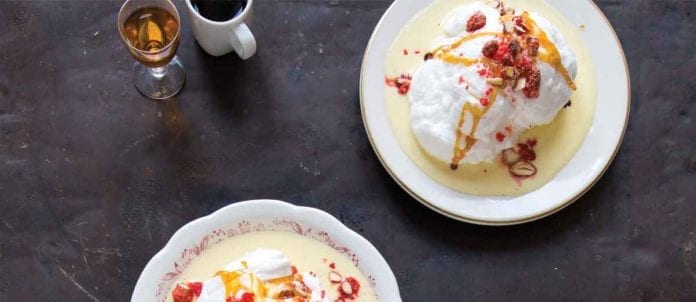Recently, an elderly guest at Chartier Restaurant lifted her fork to her mouth at the sweet culmination of her meal and rewarded her hosts with precisely the reaction they covet: she wept. The pouding chômeur was the first she’d eaten since she was a little girl in her grandmother’s kitchen. Now, at this 74-seat standout in the French-Canadian community of Beaumont, Alta., she was transported back. “If we can do that with our desserts,” says co-owner Sylvia Cheverie, “then we’ve succeeded.”
The ability to inspire such nostalgic jogs is just one of the recently identified trends defining the dessert course in Canadian restaurants. Others include the reinvention of classics with innovative twists; a shift from heavy, complicated dishes to lighter confections; the forsaking of fine-dining restaurants’ pastry departments for dessert-only shops; and simply a focus on this meal part at all. Across the board, fuelled by the so-called “Instagram effect” (the mad obsession with capturing food dishes for digital sharing), along with the enduring popularity of food-based TV, desserts are getting a fresh turn in the limelight.
The numbers support the premise. According to Toronto-based NPD Group, in the year ending Aug. 16, 2016, Canada’s foodservice operators served up approximately 445 million desserts, an increase of two per cent over the previous year. Christine Couvelier, an executive chef and a global culinary trendologist with her own Victoria-based company, Culinary Concierge, isn’t surprised. She says desserts have reclaimed top spot among diners’ post-restaurant-visit chatter. “When I’ve talked to people about their memorable meals over the last year, desserts are more often than not the standouts.”
In a nod to Chartier’s intuition, Couvier confirms “a lot of pastry chefs are creating their menus around food memories.” In some cases, that means returning to the classics with a view for nostalgic improvement. Think red velvet cake as red velvet doughnuts. “Everybody has food memories. It could be a five-star dining event, sitting on a dock at the cottage, or fish and chips in a village stopover. The idea is that food can deliver a person back to that place where the memory originated.”
For much of the past decade, however, desserts themselves were in peril of becoming a memory, as restaurants shed pastry departments. With few exceptions, they were seen as unnecessary luxuries. The restaurant scene became less about expensive bottles of wine and fanciful puddings than quick-hit tapas and taco hybrids. Slowly but surely though, fine dining has returned — and desserts are part of the comeback.
“We’ve seen a decline and an uprise in pastry culture over the last few years,” says Richmond Station chef and co-owner Carl Heinrich. “It’s really common in a kitchen for the cook responsible for the first course to also be responsible for the last. He’d toss the niçoise salad and then wash his hands and cut a slice of apple pie. That’s changing. Desserts are on the rise and the pastry chef is in high regard again.”
And more is being demanded of these chefs than ever. The crème brûlées and chocolate tartes are always going to sell, says Heinrich, whose four-year-old, 80-seat restaurant is in downtown Toronto, but the challenge now is to prepare them distinctively. “It’s less about making that perfect lemon tart and more about making something unique and creative. If you want to be on the top lists nowadays, you’ve got to make food that no one’s ever seen before.”
At Café Boulud, a French-style concept restaurant in Toronto’s Yorkville neighbourhood, pastry sous chef Joyce Wong works to create unprecedented versions of such traditional desserts as milles-feuilles and soufflés. She tweaks these classics with her own touches, including serving profiteroles under cover of a hard chocolate dome that obscures its pyramid-stacked interior until the server pours hot chocolate sauce over it. “So much of making a dessert stand out is in its presentation,” says Wong. “That’s one area where a restaurant can find a point of differentiation.”
Another is with concessions to health, the all-consuming preoccupation that’s a fixture in every other meal part. Filed under the same category as requests for vegan, gluten-free and dairy-free desserts, special-interest dietary requirements are not being ignored on restaurant’s dessert menus. Café Boulud includes gluten-free île flottante (steamed meringue, maple sugar and crème anglaise; $9) on its lunch menu; and rotisserie golden pineapple ($12), a sorbet-based treat without any gluten or dairy, on its dinner menu. Health concerns get a voice, too, in the simpler offerings some restaurants are pushing in restrained response to yesterday’s densely complex concoctions. The dessert emphasis at Foxy, a 60-seat live-fire restaurant in the Griffintown neighbourhood of Montreal, is on offering diners “something refreshing and light at the end of the meal. Nothing heavy and creamy or intensely chocolate and caramelly,” says head chef Leigh Roper. “That’s not my vibe anymore.” More her vibe? Light-touch selections such as almond and peach trottoire ($12), choco-mint ice cream terrine ($12) and Concord grape sorbet ($12).
So intense has the focus gotten on dessert that dessert-only restaurants continue to assert themselves in and among their full-menu counterparts. By 2011, frozen-yogurt shops dominated every city corner, heralded by cutesy names such as Yogen Früz and Yogurty’s. According to NPD, Canadians ate more than 12 million servings of frozen yogurt between 2010 and 2012.
Why not, says Patti Hollenberg, co-owner of Chess Piece Pâtisserie & Café, in Fredericton, N.B. She believes, since only the highest-end restaurants can afford on-site pastry chefs, dessert-specialty spots will always prevail. “My bills are a little easier for people to swallow than [the bills they’d get] going out for four-course meals with dessert,” she says.
In fact, the dessert-only restaurant enjoys a niche that falls outside of the one occupied by traditional restaurants. “We offer up our shop as a different form of entertainment,” says Hollenberg. Rather than heading out for a pint or lingering over your phone while your kid’s at hockey, people flock to dessert joints and find a whole new platform across which to engage.
Back at Chartier, where the dinner guest was so recently moved by her encounter with the pouding chômeur of her grandmother’s kitchen, co-owner Cheverie cuts to the heart of a dessert’s role in a meal. “The truth,” she says, “is no one eats dessert because they have to. It’s not sustenance, after all. Dessert fuels your soul.”
Volume 49, Number 9
Written by Laura Pratt




![Redberry Restaurants Becomes Canada’s Area Director for Jersey Mike’s Subs Expansion Redberry Jersey Mike’s Subs - Paul Pascal (left), director of Operations, and Stephen Scarrow (right), senior Marketing manager]](https://www.foodserviceandhospitality.com/wp-content/uploads/2024/04/Redberry-Appointments-218x150.jpg)













